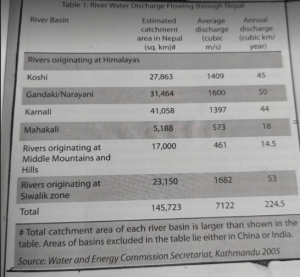– Dikshya Singh, Research officer
South Asia Watch on Trade, Economics and Environment (SAWTEE)
Nepal is plagued with hosts of problems; connectivity is only one of them. The landlockedness and difficult topography have compromised prospects of transport connectivity in this Himalayan country.
The result is over-reliance on expensive, uncompetitive and, oftentimes, unsafe surface transport.
Authorities have toyed with the ideas of developing alternate modes of transportation such as railway, ropeway and waterway but never pursued in seriousness.
Given the state of surface transport in Nepal, a possibility of utilizing the perennial Himalayan rivers that transverse the entire length of the country as inland waterways are worth exploring.
All of the rivers originating in or passing through Nepal merge with the Ganges in India to ultimately reach the Bay of Bengal through Bangladesh.
Not only would the inland waterways provide an alternative mode of transport domestically, they could also provide supplementary channels to access high seas.
Despite repeated mentions of developing waterways or, at least, exploring the possibility, Nepal so far does not have a functional waterway.
The current Prime Minister of Nepal, Mr. KP Sharma Oli, had shown interest in inland waterways during his last prime-ministership.
( Sher Bahadur Deuba is currently the Prime Minister): Ed.
Likewise, during his recent official visit to India, the joint statement issued by the two countries announced the decision to connect Nepal and India via waterways, opening a new avenue of cooperation.
In the current scenario, the decision will only facilitate the use of Indian waterways for Nepali cargo movement; but, it definitely has given rise to a sliver-lining of hope that development of Nepali waterways would be taken up in earnest.
Pursuit of enhanced connectivity through rivers is a worthwhile endeavour but, at the same time, it should be noted that developing navigable watercourses will not be an easy feat.
Considering that national and even local narratives on water resources are dominated by energy issues, with passing mentions to irrigation, discourse on river navigation is missing.
This article attempts to highlight the case for exploring issues related to inland waterways based on the existing literature.
Moreover, an attempt is made to underscore the issues that are holding back the development, and if these issues are limited to technicalities or there are other issues that need to be mindful about.
Navigating the Rivers:
Nepali rivers that originate either in the Himalayas or Chure Range drain from north to south to reach the Ganges in India.
The cumulative drainage area of these rivers is up to 191,000 sq km, of which 74 percent lies within Nepal’s territory.
The total water draining from Nepal to the Ganges River is about 270 billion cubic meters, which is 55.8 percent of the total amount of Ganges basin.

River Danube in Europe provides passage to sea for many landlocked countries.
Parana River in South America does the same to landlocked Paraguay and, closer to home; Lao PDR similarly uses Mekong River for transportation. Nepal, which has more than 6,000 rivers with a cumulative length of 45,000 km, has a potential to use its river systems to be connected to international waters.
Unfortunately, lack of institutional and physical infrastructure regarding water transport has left inland navigation an untapped sector in Nepal.
One of the biggest advantages of water transport is its cost-efficiency.
Inland water transport is considered far less expensive than road. In India, the cost of freight per tonne km is around Rs 1.41 by railways, Rs 2.58 by road and Rs 1.06 by inland waterways to transport the same cargo on the same route.
The advantages of inland water transport over other modes of transport is based on its superior record of safety, reliability, low costs, high-energy-efficiency, good carbon footprint, low infrastructure costs, among others.
The environmental advantages of water transport are substantial as the fuel required to move freight by inland waterways is 60 per cent that of rail and only about 15 per cent that of trucks.
Unlike roads, infrastructure construction cost for waterways are comparably low to road infrastructure while maintenance costs are also limited.
Considering India’s renewed push towards developing its inland waterways as an effective mode of alternate transportation, new avenues could open up for Nepal as well.
In April 2016, India enacted a new National Waterways Act that declared 106 additional waterways to the existing five.
The Ministry of Shipping that governs inland waterways in India has launched Jal Marga Vikas Project that is being implemented with financial and technical support of the World Bank.
The US$800 million project aims to increase cargo movement via inland waterways to 15 per cent of the total freight in 2019, which stood at 3.5 per cent in 2017.
As per the plan, Indian government has already started works on construction of multi model terminals at Varanasi in Uttar Pradesh, Sahibgunj in Jharkhand and Haldia in West Bengal along the Ganges River, which is officially identified as National Waterway-1 (NW-1).
In addition, to serve the water transport in NW-1, India is constructing two intermodal terminals in Kalughat in Bihar and Ghazipur in Uttar Pradesh; five Roll-On-Roll-Off terminals as well as a new navigational lock in Farakka, River Information System, vessel repair and maintenance facilities and Ro-Ro terminals, which are envisaged to be completed by December 2022.
River Danube in Europe provides passage to sea for many landlocked countries.
Parana River in South America does the same to landlocked Paraguay and, closer to home, Lao PDR similarly uses Mekong River for transportation.
Nepal, which has more than 6,000 rivers with a cumulative length of 45,000 km, has a potential to use its river systems to be connected to international waters.
Unfortunately, lack of institutional and physical infrastructure regarding water transport has left inland navigation an untapped sector in Nepal.
One of the biggest advantages of water transport is its cost-efficiency.
Inland water transport is considered far less expensive than road. In India, the cost of freight per tonne km is around Rs 1.41 by railways, Rs 2.58 by road and Rs 1.06 by inland waterways to transport the same cargo on the same route.
The advantages of inland water transport over other modes of transport is based on its superior record of safety, reliability, low costs, high-energy-efficiency, good carbon footprint, low infrastructure costs, among others.
The environmental advantages of water transport are substantial as the fuel required to move freight by inland waterways is 60 per cent that of rail and only about 15 per cent that of trucks.
Unlike roads, infrastructure construction cost for waterways are comparably low to road infrastructure while maintenance costs are also limited.
Considering India’s renewed push towards developing its inland waterways as an effective mode of alternate transportation, new avenues could open up for Nepal as well.
In April 2016, India enacted a new National Waterways Act that declared 106 additional waterways to the existing five.
The Ministry of Shipping that governs inland waterways in India has launched Jal Marga Vikas Project that is being implemented with financial and technical support of the World Bank.
The US$800 million project aims to increase cargo movement via inland waterways to 15 per cent of the total freight in 2019, which stood at 3.5 per cent in 2017.
As per the plan, Indian government has already started works on construction of multi model terminals at Varanasi in Uttar Pradesh, Sahibgunj in Jharkhand and Haldia in West Bengal along the Ganges River, which is officially identified as National Waterway-1 (NW-1).
In addition, to serve the water transport in NW-1, India is constructing two intermodal terminals in Kalughat in Bihar and Ghazipur in Uttar Pradesh; five Roll-On-Roll-Off terminals as well as a new navigational lock in Farakka, River Information System, vessel repair and maintenance facilities and Ro-Ro terminals, which are envisaged to be completed by December 2022.
Given the scale of infrastructure development that India is undertaking and intricate transit network between Nepal and India, it is but natural for India to look for diverse users of the waterways to make it financially viable project.
Nepal, which did trade worth more than NPR 1000 billion using Indian transit routes in 2017, could definitely use additional mode of transport.
The April 2018 decision between the Prime Ministers of Nepal and India related to cooperation on inland waterways will allow movement of Nepali cargo through the Indian waterways, notably NW-1.
Moreover, the intermodal terminal being built at Kalughat, near Patna in Bihar, is aimed at rerouting a part of Nepali cargo that is transported on rail or road at present.
Similarly, the under-construction Gazipur terminal in Uttar Pradesh will have a dedicated terminal for exporting liquefied natural gas to Nepal.
The advantages associated with the inland waterways regarding lower cost and emission makes it worthwhile to have an additional alternate mode of transport for Nepal.
More importantly, among the eight waterways identified by the Inland Waterways Authority of India (IWAI) for development in Phase I include Gandak (NW-37), Kosi (NW-58) and Ghaghra (NW-40), which are the Himalayan rivers known in Nepal as Saptagandaki or Narayani, Koshi and Karnali, respectively.
Text courtesy: Association of Former Career Ambassadors of Nepal( AFCAN), Journal on Strategies for the Development and Management of Nepal’s Water Resources, 2020, edited by Dr. Khaga Nath Adhikari.
# Published with the direct permission of the AFCAN President. Ambassador Dr. Ram Bhakta Thakur. Thanks the distinguished author and President AFCAN: Ed. Upadhyaya.
Our contact email address is: editor.telegraphnepal@gmail.com

